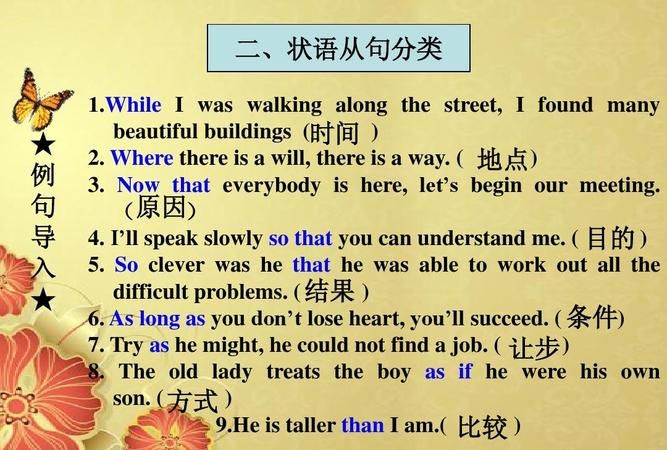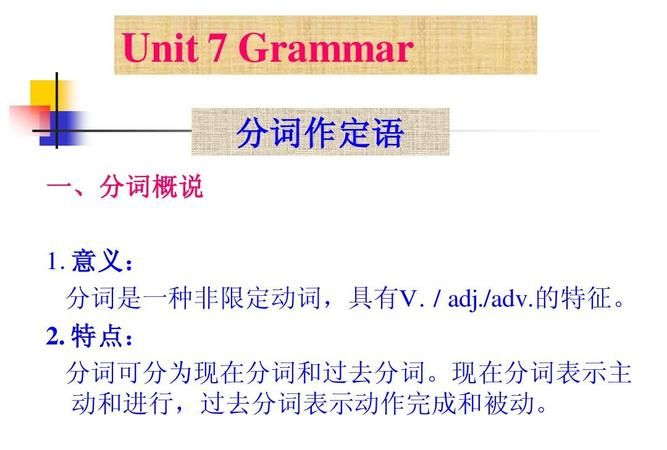本文目录
分词作状语什么意思
现在分词作状语 ,表示动作发生的时间、原因、结果、条件、让步、方式或伴随情况,通常相当于一个状语从句或并列分句。
一般说来,这种结构的逻辑主语就是句子的主语。

什么是分词作状语英语
这是非谓语动词的用法,英语中的三种非谓语动词你要熟悉哦!
那就是现在分词短语(动名词短语)、过去分词短语、动词不定式短语。
非谓语动词除了不能独立作谓语外,可以承担句子的其他成分。所以你问的“分词做状语是干什么的 ? ”它作用很广泛了,作状语只是其中的一个用法。
还有,你要清楚什么是状语?
状语说明地点、时间、原因、目的、结果、条件、方向、程度、方式和伴随状况等。
先讲讲你说的现在分词短语(动名词短语)作状语。
①作时间状语:
(While) Working in the factory,he was an advanced worker.
在工厂工作时,他是一名先进工人。
②作原因状语:
Being a League member,he is always helping others. 由于是共青团员,他经常帮助他人。
③作方式状语,表示伴随:
He stayed at home,cleaning and washing. 他呆在家里,又擦又洗。
④作条件状语:
(If) Playing all day,you will waste your valuable time.
要是整天玩,你就会浪费宝贵的时间。
⑤作结果状语:
He dropped the glass,breaking it into pieces. 他把杯子掉了,结果摔得粉碎。
⑥作目的状语:
He went swimming the other day. 几天前他去游泳了。
⑦作让步状语:
Though raining heavily,it cleared up very soon.
虽然雨下得很大,但不久天就晴了。
看了以上的,有没有发现其最大的一个特点就是:两个部分中动作的主语是一致的(要使用这种结构这个是必须的),再分析下你补充的这个英语句子。
老鼠看见了猫,所以它逃跑了。
你看看这里动作的主语都是老鼠。
完整的结构可以写成:
As soon as it saw the cat ,the mouse ran off. (When引导了时间状语从句)
老鼠一见到猫就逃跑了。
也可以写成:
Because it saw the cat ,the mouse ran off. (because 引导的原因状语从句)
老鼠因为见到了猫,所以逃跑了。
看你加些什么引导词,则做了什么形式的状语。
不管怎样,状语从句中的主语和主句中的主语一致的,一般可将引导词和主语一并省略,构成省略句。
主语和动作的关系是主动关系,(老鼠见到猫,老鼠主动发出的动作)则用现在分词短语(动名词短语)结构。
例如:Seeing the cat, the mouse ran off.
如果主语和动作的关系是被动关系,则用过去分词结构来表示。
例如:Caught in a heavy rain, he was all wet.
因为淋了一场大雨,所以他全身湿透了。(他是被雨淋了。)
为什么这样用?事实上也是英语文学上的一些表现手段。事实上我们汉语也是这样用的,只是换成英语后,就要用它约定俗成的一种规则。非谓语动词是个难点,慢慢揣摩吧!一步一步来!
希望可以帮到你!

过去分词简化状语从句
情形一:从句主语和主句主语一致
步骤:去(从句)连词—去(从句)主语—(从句)谓语变分词
时间状语从句
1、 以when,while引导的时间状语从句和以if引导的条件状语从句,谓语动词是主动语态时,如果从句谓语动词所表示的动作是与主句谓语同时发生,可简化为现在分词的一般式;如果从句谓语动词所表示的动作发生在主句谓语之前,则可简化为现在分词的完成式。
When we heard (=When hearing/Hearing)the teacher's pleasant talk to us, we began to feel comfortable.
While Mary was standing(While standing/Standing) in front of the teacher, she(Mary) was very nervous.
状语从句的谓语动词是被动语态时,可简化为过去分词。
When /If it is heated to a high temperature(=Heated to a high temperature),water will change into steam.
If we are given(=Given) more time, we can do the work better.
If the city is seen(=Seen) from the mountain, it(the city) looks very beautiful.
2、以after,before引导的状语从句可用after,before+从句谓语动词的动名词(短语)形式构成介词短语作状语。
After he put on (=After putting)the trousers, he found they were 2 inches too long.
也可:Having put on the trousers, …
Before we do the job(=Before doing the job), we'd better think it over.
3、以as soon as 引导的状语从句,可用On+谓语动词的动名词形式作状语,此时的动词是非延续性动词。
Doctor Bethune began to operate on the wounded soldiers as soon as he arrived (=On arriving)at the village.
2、原因状语从句
可简化为分词短语作状语。
Since you still look pretty sick(=Looking pretty sick), you'd better have a good rest.
Because he was(=Being) one of the best teachers in the city, he was given a medal.
Since I didn't know Chinese(=Not knowing Chinese), I tried to speak to her in English.
情形二:从句主语和主句主语不一致
步骤:去连词—留主语—动词变分词
当状语从句的主语与主句的主语不一致时,状语从句简化成分词短语时则要保留其本身的主语,使该主语成为分词短语的逻辑主语,即构成独立主格结构(主语+分词)。例如:
As it was fine that day(=It being fine that day)),we decided to go fishing.
Since his father had fallen ill(His father having fallen ill),John had to begin working at the age of ten.
If weather permits(=Weather permitting), we will have a picnic.

现在分词作状语用法例句
1、现在分词doing所代表的动作或状态与谓语动词是同时或几乎是同时发生的,可以作时间、原因、方式、条件、结果、目的、让步、伴随等状语。分词的逻辑主语就是句子的主语。
2、有些分词作状语,没有逻辑上的主语,已成为习惯用法:considering,judging from,talking of,allowing for(考虑到),generally/frankly/honestly/roughly/strictly speaking,assuming that(假设)等。

现在分词的基本特点
1、在时间上
表示动作正在进行。
例如:a developing country.一个发展中的国家,boiling water沸水,rising sun冉冉升起的太阳。(试比较:a developed country一个发达国家,boiled water沸水,risen sun升起的太阳)
2、在语态上
表示主动。
例如:the ruling class统治阶级,the exploiting class剥削阶级。(试比较:the ruled class被统治阶级,the exploited class被剥削阶级)
以上就是关于分词作状语从句 ,分词作状语什么意思的全部内容,以及分词作状语从句 的相关内容,希望能够帮到您。
